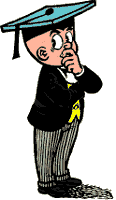Adhemar (comic book character)
| Adhemar | |
|---|---|
 | |
| Publication information | |
| Publisher | Standaard Uitgeverij (Belgium) |
| First appearance | The Adventures of Nero: De Zoon van Nero (1959) |
| Created by | Marc Sleen |
Adhemar is a Flemish comic book character. He is the son of
The Belgian comic book award Bronzen Adhemar has been named after him.[1]
Debut
Adhemar made his debut in De Zoon van Nero ("The Son of Nero") (1959), in which he is also born. He surprises his parents and all other people present by being able to talk, smoke a pipe, drink beer and choose his own name. When Nero takes him to the child benefit office he convinces the man behind the counter to raise the money. Later in the story Adhemar wants to leave to see something of the world, but is halted by Petoetje, adoptive son of Meneer and Madam Pheip. He introduces Adhemar to science, which will become his major hobby in the course of the series. Adhemar invents a new petroleum device in the story and strikes oil in their garden, which causes Nero to get rich and convince him that Adhemar's genius ought to be stimulated.
Adhemar had a few predecessors in the series. In the very first Nero album, Het Geheim van Matsuoka ("The Secret of Matsuoka") (1947-1948) Nero is portrayed with a son and daughter on his knee. In later prints they are changed into his nephews. In
Character
In his first twelve albums Adhemar was dressed as a baby, walking around with a
In some stories Adhemar returns to his childish state of mind, like "Het Zevende Spuitje" ("The Seventh Syringe") (1963) or "De Wallabieten" ("The Wallabytes") (1968), but most of the times he is the most adult of all the characters. He is a
Despite his high I.Q. Adhemar does sometimes makes human errors or turns out to be fallible. His inventions sometimes fail or his laboratory explodes. Some of this failings also lead to new adventures, for instance in "Het Zevende Spuitje" or "Aboe-Markoeb" (1966). In "De Witte Parel" ("The White Pearl") (1962) he is humiliated on television when it turns out he doesn't know any nursery rhymes during a quiz. He decides to go to kindergarten to extinguish this hole in his knowledge.
Many scientists and professors know and admire Adhemar. In "Het Bobobeeldje" ("The Bobo Statue") (1965) we see a signed photograph of Albert Einstein with the message "To my dear friend Adhemar", despite the fact that Einstein died in 1955, four years before Adhemar's birth in the series. Due to Adhemar's genius several people and foreign regimes sometimes abduct him to force him to work for them.[2] Some professors try to murder him out of jealousy.
In "De Blauwe Mannen" ("The Blue Men") (1969) Adhemar turns out to be a fan of
.Child prodigy
Adhemar's main character trait is his
Adhemar teaches at several universities, including the
to "extinguish the fire".Adhemar often puts his intelligence in advantage to the US government. In "De Brollebril" (1960) he sells it for 50.000 dollar. In "De Driedubbelgestreepte" ("The Three Double Striped One") (1962) the Americans want to use him in the
Political career
Usually Adhemar acts more like a consultant to governments or offers his inventions to leaders of the West, but in "De Kromme Cobra" ("The Crooked Cobra") (1964) he becomes Prime Minister of the Indian state Rachepour.
Cultural status
As one of the most recognizable Flemish comic book characters Adhemar has penetrated Flemish popular culture in many ways. The annual comic book award Bronzen Adhemar has been named after him and is a small statue modelled after his likeness. In Turnhout, where the prize is traditionally handed out, he also received a statue near De Warande in 1991. It was designed by sculptor Ivo van Damme.[9] On 5 September 2016 the statue was victim of vandalism and pushed of its plint, but quickly put back again the next day.[10] A book store in Gent has been named after him too [11]
He is included along with other Nero characters on a bas-relief in Sint-Niklaas, made by sculptor Paul Dekker in 1988 to commemorate Marc Sleen's induction as an honor citizen of the city.[12] In 1995 a special wall near the Saint-Géry Island in Brussels celebrating Nero characters, also included him.[13]
Sources
- ^ "Bronzen Adhemar | Strip Turnhout".
- ISBN 978-9004237292.
- ^ "De Paardekop" ("The Horse Head"), Standaard Uitgeverij, (1976).
- ^ "Aboe-Markoeb", Standaard Uitgeverij (1976). (1966)
- ^ "Magellaan II", Standaard Uitgeverij (1971)
- ^ "De Paprikanen", Standaard Uitgeverij (1971)
- ^ "Papa Papoea", Standaard Uitgeverij, (1980)
- ^ "De Nerotiekers" ("The Neroticians"), Standaard Uitgeverij (1970).
- ^ http://www.standbeelden.be/standbeeld/1764[permanent dead link]
- ^ "Sokkel engels - Google Search".
- ^ "Adhemar - Onthaal".
- ^ "Paul Dekker - de Wafelenbak". Archived from the original on 2016-11-10. Retrieved 2015-09-28.
- ^ "Externe activiteiten — Belgisch Stripcentrum - Museum Brussel".
